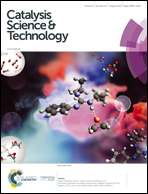A mini review of in situ near-ambient pressure XPS studies on non-noble, late transition metal catalysts
Abstract
Due to the increasing prices of noble metals and the progress in synthesis of nanomaterials, non-noble transition metal catalysts have gained considerable interest in heterogeneous catalysis research. Transition metals can have multiple oxidation states, depending on the surrounding environment (gas atmosphere, pressure and temperature) and the ionic species they are bonded to. Understanding the relationship between catalytic surfaces and their performance is crucial for the design of new transition metal catalysts and the optimization of those already in use. X-ray photoelectron spectroscopy (XPS) is one of the most powerful spectroscopic tools to obtain chemical information of solid surfaces. However, conventional XPS instruments operate under ultra-high vacuum conditions (<10−8 mbar) limiting the characterization of catalysts, before and after reaction. Recently, a new type of XPS apparatus has emerged, allowing in situ measurements of catalysts in gaseous environments in the mbar pressure range. These “environmental XPS” systems, commonly referred to as near ambient pressure XPS (NAP-XPS), have opened up new opportunities to study dynamic modifications at surfaces and correlate them with the catalytic performance. In this review, we discuss NAP-XPS studies of non-noble, late transition metal catalysts (Fe, Co, Ni and Cu) in reactive gas or vapour phase environments. The aim is to describe the rich chemistry of those transition metal surfaces under conditions resembling the catalytic reaction and to provide crucial elements for sophisticated design of next generation catalysts.



 Please wait while we load your content...
Please wait while we load your content...